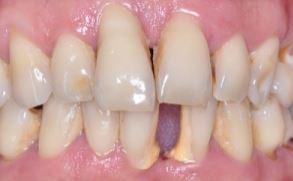Periodontis Vs Gingivitis
Understanding the Differences for Better Oral Health

Gingivitis and periodontitis are forms of gum disease, gingivitis is a reversible condition characterised by inflammation of the gums, while periodontitis is a more serious condition involving bone loss and irreversible damage. Early detection and treatment of gingivitis can prevent the progression to periodontitis, emphasising the importance of regular dental check-ups and maintaining good oral hygiene practices.
Periodontitis is a serious gum infection that damages the soft tissue and, if left untreated, can lead to the destruction of the bone that surrounds and supports the teeth. It is considered a more advanced stage of gum disease that follows gingivitis, which is the early and reversible form of gum disease characterised by inflammation of the gums.

The primary cause of periodontitis is the accumulation of dental plaque—a sticky film of bacteria that forms on the teeth. If plaque is not removed through proper brushing and flossing, it can harden into tartar (calculus), which can lead to gum disease.
The bacteria in plaque can produce toxins that irritate the gums, leading to inflammation and infection. Factors that increase the risk of developing periodontitis include:
- Poor oral hygiene habits.
- Smoking or tobacco use.
- Genetic predisposition.
- Certain medical conditions (e.g., diabetes).
- Hormonal changes (e.g., during pregnancy).
- Medications that reduce saliva flow.
- Stress.
- Nutritional deficiencies.
Common symptoms of periodontitis include:
- Persistent bad breath.
- Red, swollen, or bleeding gums.
- Gum recession (gums pulling away from teeth).
- Formation of deep pockets between gums and teeth.
- Loose teeth or tooth mobility.
- Changes in the way teeth fit together when biting.
If not treated, periodontitis can lead to serious complications, including:
- Tooth loss due to the destruction of the supportive bone and tissues.
- Increased risk of systemic health issues, such as heart disease, diabetes complications, and respiratory diseases.
A dentist or periodontist diagnoses periodontitis through:
- Clinical examination of the gums.
- Measuring pocket depth using a periodontal probe.
- X-rays to assess the extent of bone loss.
Treatment
Treatment for periodontitis varies based on the severity of the condition and can include:
- Scaling and Root Planing: A deep cleaning procedure to remove plaque and tartar from below the gum line and smooth the tooth roots to promote healing.
- Medication: Antibiotics may be prescribed to help control infection, either topically in the form of gels or in pill form.
- Surgery: In advanced cases, surgical options such as flap surgery or bone grafting may be necessary to restore damaged tissues and bone.
- Ongoing Maintenance: Following initial treatment, regular dental visits and continued good oral hygiene practices are essential to prevent recurrence.

